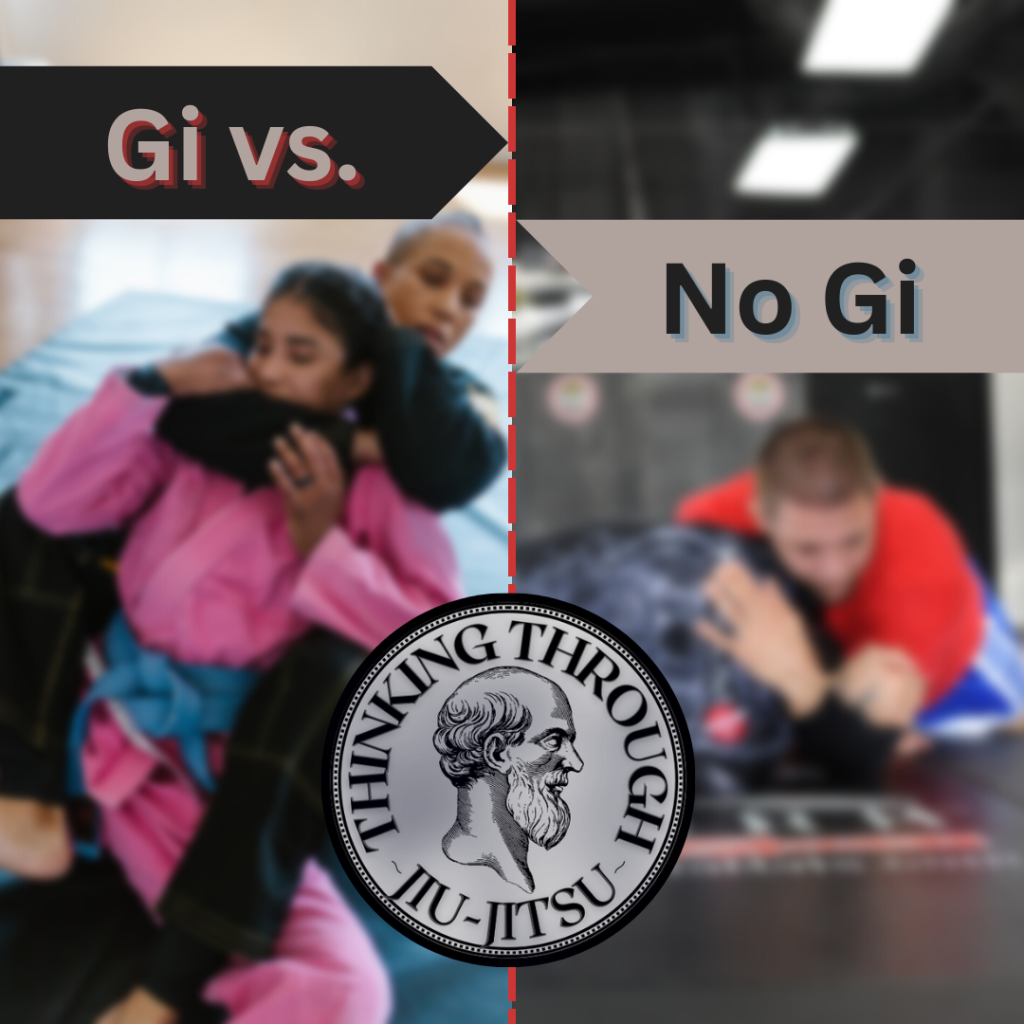If you’ve been around Jiu-Jitsu as long as it takes to say the name, then you’ve likely heard this argument. Gi or no gi. A constant struggle for a Jiu-Jitsu practitioner is deciding on what to focus on. Depending on schedules and your school, your options may be limited, and you may have to pick between the two. And while gi and no gi are two sides of the same coin, they couldn’t be more different. There’s arguments for both sides of the coin which I’ll provide a brief fly over and share my thoughts along the way.
The first thing I’ll tackle is the cost difference. There is a financial commitment to training in the gi. For training no gi, even if you go out and spend money on grappling shorts and a rash guard, if you quit three months down the road, that gear can be worn as regular athletic attire. There’s not much outside the Jiu-Jitsu world for a gi. Trust me, I’ve tried to convince my brother to let me wear one of my swankier gis at his wedding. It didn’t fly.
One of my personal favorite things about training in the gi is being able to control the pace. If need be, you can lock down some grips and give yourself a little time to breathe and think. Wearing the jacket and pants also slows down the matches from the friction they provide. All of this is especially helpful when you have a young, athletic go-getter. Some good gi grips can have them come screeching to a halt. Plus, all those grips are a great forearm workout. Wanna look like Popeye? Train gi grips.
But that’s not to say there aren’t good, fundamental grips to learn in no gi. Learning how to grip in no gi is a different animal. Typically you’ll be using your whole hand to grip entire parts of the body. Gripping the wrist, ankle, knee, elbow, neck, lat, etc. is different when there isn’t material to bite down on. No gi grips are a bit easier to break, so focusing on how to use the grip and the rest of your posture to better maintain the grip is a huge bonus, both in and out of the gi.
Where you can slow thing down in the gi, the pace in no gi is much faster. Due to the accelerated pace, you must be more technical and more aware of your body control. Move too fast or too slow and you may give up a position. No gi demands quick thinking and reaction based on feel as sometimes your reaction needs to be immediate and doesn’t allow that split second to think it through.
When training in the gi, you have to be aware of chokes. Lapel chokes are nearly always a threat, and can be set up and thrown at you in an instant. You learn to be aware of and protect your neck constantly. Many matches go by with intense grip battles simply for this reason. If you leave a deep lapel choke go unchecked for too long, you’ll likely end up in a world of hurt.
While lapel chokes haunt the gi game, no gi attacks are usually quicker and more direct. In the gi, you may recognize someone setting up a cross-collar, or other lapel choke, whereas in no gi some of those chokes and other submissions come on with such surprise because you honestly never see them coming. Because of this, I feel that positional advantages are more important in no gi.
Getting back to the gi, while standing up you may notice a gi match spends precious moments in a grip battle. The gi is there, why not use it. The gi allows for many great takedowns and throws and can work to slow down someone else’s attempt to take you down. On the other side of the coin, no gi helps to develop your wrestling. You must be able to shoot in or defend without the setup of gi grips and posture control.
Finally, I more closely relate training in the gi to self-defense. Typically, people are wearing clothes, and if you wear clothes in a fight with me, I will likely be going for grips to help me control the fight. Whether it is to slow down the pace, break down your posture or just simply control you, I’m going to grab onto whatever cloth there is.
As you can see much of the argument comes down to grips. I do love the grips in gi Jiu-Jitsu as it adds a dynamic element and allows for either practitioner to slow things down a bit. Then you have the no gi grips, which I do like having in my tool belt, but from where I’m standing, any grip you can do in no gi, you can do in the gi. It obviously does not work the other way around.
If anyone cares, I train both pretty equally. One thing I’ve noticed is that it seems that whenever I hit a slump in one my game gets better in the other. It’s almost like no gi is the plateau buster for gi and vice versa.
In the grand scheme of things, both gi and no gi benefit your game. If you ask me, I’d say to try both out, see what suites you, but I would not completely neglect one for the other.
Thanks for reading.

